We were all a little surprised just how quickly last week’s Quake remaster came about, going from rumours and ESRB sightings to available on PSN and Steam in no time flat. Now, many people are playin’ id Software’s landmark 1996 first-person shooter for the first time. Welcome!
Despite being one of the most important video games ever made, the original Quake is a weird hodgepodge of conflicting creative impulses, a loveable mess that works almost despite itself. It’s also a key part of how I got my first games job way back when, so not only am I glad to see it back in the spotlight, I thought I’d share some tips on how to best thrive in id’s strange, brilliant ode to hyperviolence, Lovecraft, and extremely phallic guns.
This guide is PC focused, but all of the gameplay stuff carries over onto consoles, too. If you just want the PC cheats, skip to the end! Right now, let’s talk weapons…
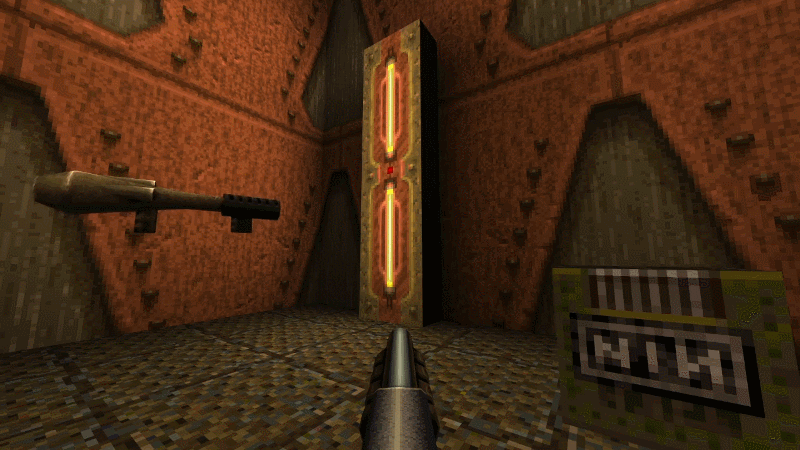
Quake’s arsenal is super unbalanced
If you’re coming from Doom, you might be surprised to see Quake’s default weapon is the Shotgun (aka “boomstick”). But it’s a “shotgun” in name only, a little plinker not good for much beyond stunlocking weaker single-player foes or maybe sapping a distant, injured player’s final hitpoints. To be honest I have no idea what Trent Reznor was thinking when he made its sound effect. I guess you can say it’s appropriately wimpy.
Similarly, the Super Shotgun is nothing like its Doom II counterpart. It kills monsters twice as fast (albeit at shorter range) but is more or less junk in multiplayer outside of close-range final-shot scenarios. I do like how it can occasionally gib weak monsters, though. Or most things, if you have the Quad Damage power-up.
It’s not as junk as the standard Nailgun, though, which sends dual streams of weak, easily avoided nail projectiles toward foes. This is useful against lesser enemies (especially Scrags), but a joke in deathmatch. The Super Nailgun (aka Perforator) can kill monsters very quickly but really eats through ammo. It’s a key anti-Shambler tool, since those debatably furry interdimensional horrors are resistant to explosives. But you guessed it, not a great choice if you wanna take out another player.
The Grenade Launcher (“GL”) is the first of your two explosive guns, and is just as powerful as the Rocket Launcher. It’s great for clearing out tough crowds in single-player, but the drawback is these pineapples only detonate if they collide with a foe in mid-air or sit on the ground for a few seconds. This is easy enough against monsters, but it can be real hard to reliably arc them into agile players. Nevertheless, you at least have a chance at getting lucky, and more to the point, grenades can be useful for a bit of suppression / area denial or just hopin’ some elder god is smiling when you randomly toss a few down a hallway.
At last, the Rocket Launcher (“RL”)! Quake multiplayer is balanced around this strangely powerful, disconcertingly phallic rod. Damage is the same as grenades. The key difference here is that its projectiles travel very quickly and explode immediately upon impact with geometry. Players can still be tricky to hit directly, but you don’t need to, because you can inflict excellent splash damage by merely shooting at the ground near their feet. This is a primary tactic for killing other players. If you get Quad Damage, opponents better make themselves scarce until it runs out (or until you accidently blow yourself up).
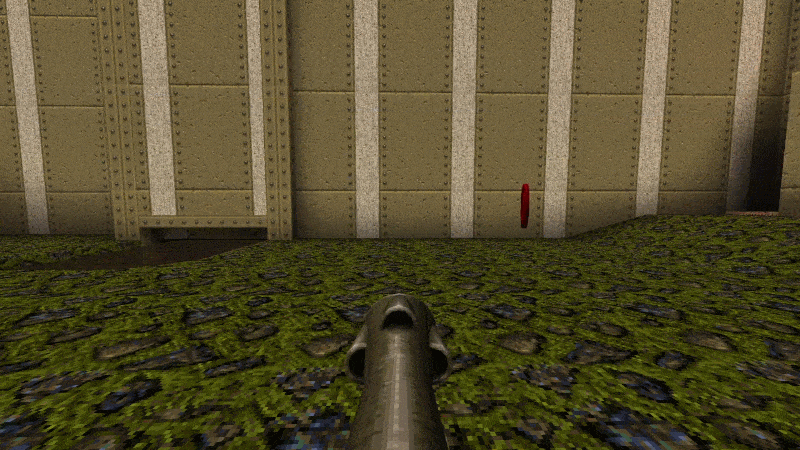
The Rocket Launcher also grants vastly improved mobility via a technique called rocket jumping. You’ve probably done it in other games: Just look down, fire a rocket, and jump at around the same time. Up you go, far higher than any normal jump could take you. (You can also aim at a less severe angle while running backward to travel further rather than higher.) Rocket jumps inflict a fair amount of damage, so they’re usually calculated risks. Sometimes it’s worth beating your opponent to a key power-up, or surprising them from a weird angle.
(Grenade-jumping is a thing too, but it’s far more fiddly and less applicable to most in-game situations. Speedrunners love it though.)
Quake’s final weapon is the Thunderbolt / Lightning Gun (“LG”), which chews through “cell” ammunition at a breathtaking rate to emit a stuttery, medium-range beam that melts anything’s health. The lack of ammo means you won’t often use it as a primary weapon; its main utility comes in finishing off ailing foes or, more commonly, supplementing your rocket damage mid-fight. A common tactic is to bounce an opponent into the air with a rocket and then quickly switch to the “shaft” (yep) to light them up during their helpless flight. Many duels are won this way.
Firing the Lightning Gun underwater discharges all cell ammo and kills everything in sight, including you, unless you have invincibility from the Pentagram of Protection…which you usually don’t. But once in a while, like when multiple opponents are swimming, “discharging” like this might be worth the suicide.
Oh, you also have an Axe. Never use it unless you wanna save ammo on weak grunts, open secret walls, or style on a friend.
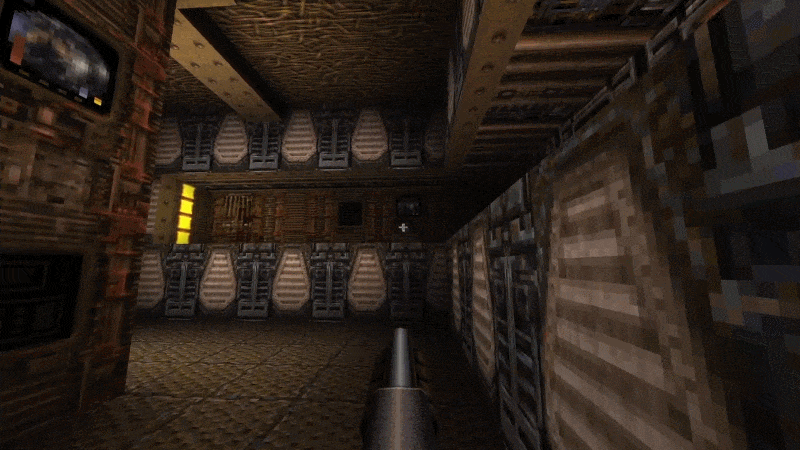
Tips for single-player
Single-player Quake is…fine. It’s no Doom, but this re-release has served as a reminder that solo Quake has a decent-sized fanbase. That’s cool. The Quake remaster gives you the four original episodes, the two original mission packs, and two newer episodes from MachineGames. That’s a lotta single-player! Here are a few tips to make it through the meat grinder.
Like in Doom, finding secret areas full of the best power-ups can be hugely beneficial, not to mention fun. So, always be observing your environment for odd-looking walls, unusual constructions, etc. If something looks strange, odds are a secret is lurking. You can usually open / activate them by either shooting something (the wall itself will bleed) or bumping into a button / pressure plate. Unlike Doom, Quake has no “use” key, so RIP wall humping.
Quake features smaller crowds of enemies than Doom, but individual enemies tend to be deadlier. The smallfry include Rotfish, Rottweilers, hitscan Grunts and laser-wielding Enforcers, Zombies (gib them or they will resurrect), flying Scrags, and melee-only Knights. Aside from the Zombies, all these enemies are best tackled with shotties or nailguns. Explosives are fun if you’re in the mood, though.
Moving up we meet the Ogre. If you stand close they’ll perform a devastating chainsaw swipe, and at any other range will spam grenades. Seriously, they spam. Since gravity exists, it’s very bad to have Ogres above you, as they’ll just keep raining down explosives. Luckily, you can knock them down for a while with the Super Shotgun. To vanquish, snipe with nails or the regular Shotgun from afar, or land four Super Shotgun blasts up close. You can dance in and out of their chainsaw range to get them to commit to melee, all the while blasting them.
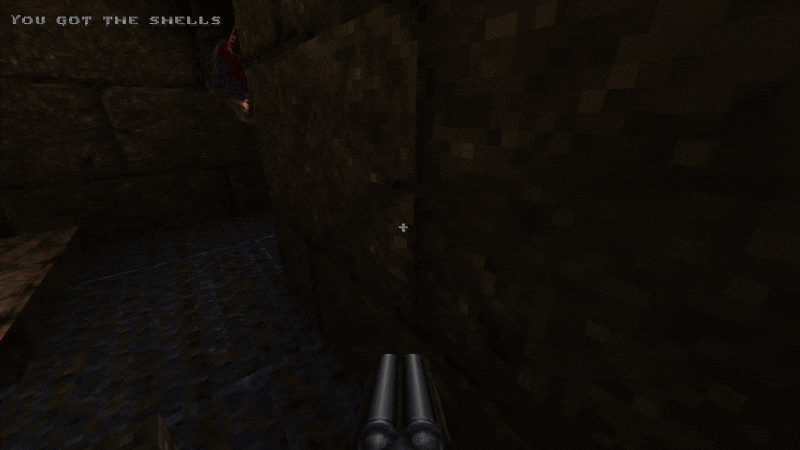
Death Knights are just Knights with twice as many HP and a five-way projectile you can jump over. Not too bad; just don’t let them reach sword range. Fiends, however, you wanna pay attention to. These aggressive melee bastards can leap massive distances to get in your face, hurting you with both the impact and the rapid slashes they’ll commence upon landing. You can’t let Fiends live long, so when you hear the bad sound drop everything else to start backing up while unloading your super shotty or Perforator.
Shamblers and Vores are more or less minibosses. Shamblers have a powerful line-of-sight lightning attack (kinda like Doom’s Arch-vile) and devastating close-range slashes. Vores have one attack, the most annoying homing projectile in a ‘90s FPS. This explosive will hit you if you don’t zip around a nearby corner in the tightest possible fashion. Against either foe, it’s crucial to use nearby geometry for cover. Slink into hiding when the Shambler raises its hands, or a Vore ball draws near. Any weapons work on Vores, but as mentioned, Shamblers take half damage from explosives, so try Super Nailgun or Lightning Gun.
Spawns are…well, you’ll see in Episode 4. Sandy Peterson hates you.
Finally, the first and fourth episodes end with the main game’s only true bosses. Both are vanquished with environmental gimmicks, so don’t bother shooting them. Look around the arenas and you’ll figure out how to kill ‘em soon enough.
Multiplayer is Quake’s beating, violent heart
Despite — or maybe because of — its bizarrely lopsided game balance, Quake really shines in competitive multiplayer. This remaster only has middling netcode, so you may well run into lag problems. If you really get into it, you may want to graduate from the remaster to one of the multiplayer-focused source ports, which will offer smoother online play (QuakeWorld support) across more servers. Finding populated matches may be harder, though.
If all else fails, the remaster features pretty nice bots, so you can get a taste of the mayhem by playing local games against a bunch of AI opponents. They’re not the smartest, but they gib real nice.
While you can play multiplayer in just about any map, Quake came with six dedicated deathmatch arenas. DM2, DM4, and DM6 are typical for duels, while the larger DM3 became the teamplay gold standard. DM1 is a Rocket Launcher-lacking abomination, and DM5 never gets invited to parties. The first mission pack, Scourge of Armagon, included a single dedicated deathmatch map, HIPDM1, and this new remaster includes an additional four arenas in the base game.
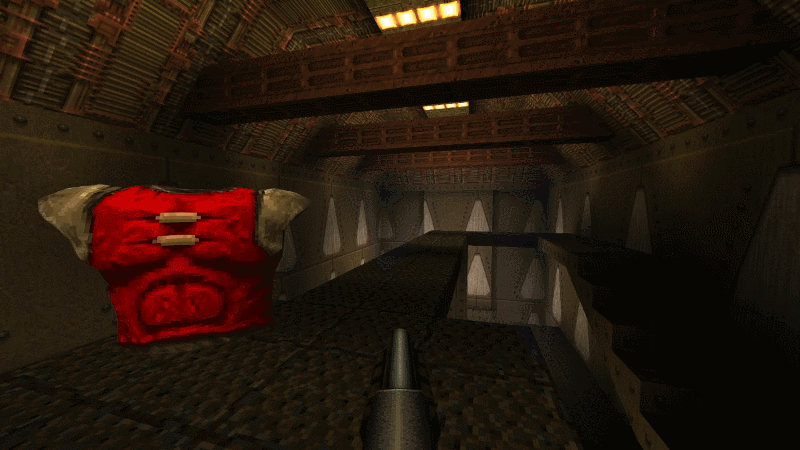
Control the items, control the map
Anyway, let’s assume you find some reasonable-quality matches. What do? Simple, make a beeline for weapons, armour, and power-ups. Quake Guy is completely useless when he spawns, what with that tiny Shotgun and laughable Axe.
When I say “weapons,” I really mean the Rocket Launcher followed by the Lightning Gun. The Grenade Launcher is a consolation prize. Everything else is pretty bad unless your foe’s just respawned or you have Quad Damage. If the server uses competitive rules weapons will disappear upon pickup, respawning 30 seconds later. This lets you hoard key guns and deny them to opponents, which is an incredibly important strategy.
Upon death you drop a backpack containing all of your ammo, as well as the last weapon you wielded. So if someone manages to kill you, they can get that Rocket Launcher you were hoarding. A really advanced strategy is thus to switch to the Shotgun right before you die, but who the heck knows when they’re about to die? I don’t bother worrying about this, it seems unfun. You could technically rig up some aliases (see below) to help achieve this strategy, but that crosses a line in my opinion. Too cheaty.
While securing a Rocket Launcher is key, don’t sleep on Armour, which grants absolutely remarkable damage reduction. I find the precise maths behind Quake armour baffling, but the basics are that Green Armour (which grants 100 armour units) absorbs 30% damage, Yellow Armour (150 units) absorbs 60% damage, and Red Armour (200 units!) absorbs 80% of all damage.
So Yellow Armour is great, grab it to deny it to your opponent when you can. But Red Armour? It increases survivability to such a high extent that it rivals the Rocket Launcher in importance. Do you want to be able to survive two direct rockets, or would you rather your opponent have that advantage? Oh, you want it? Well, you better be on top of that Red Armour every time it spawns, which is every 20 seconds.
Completing the pick-up trifecta are the limited-time power-ups. The most important are Quad Damage (30 seconds of uber killing power) and the Pentagram of Protection (30 second of invulnerability. The Quad respawns every 60 seconds (so 30 seconds after it expires) while the Pentagram takes a solid five minutes to come back.
The Pentagram is fairly rare and has that long respawn time, but Quad? Just like Red Armour, if you let your opponent control the Quad you’re going to have a bad time. Better players than me will mentally keep tabs on the expected respawn times of the Quad, Red Armour, and so on. That way they can aim to pass by at just the right time, snatching up the resource just as it spawns and denying it to their enemy once more.
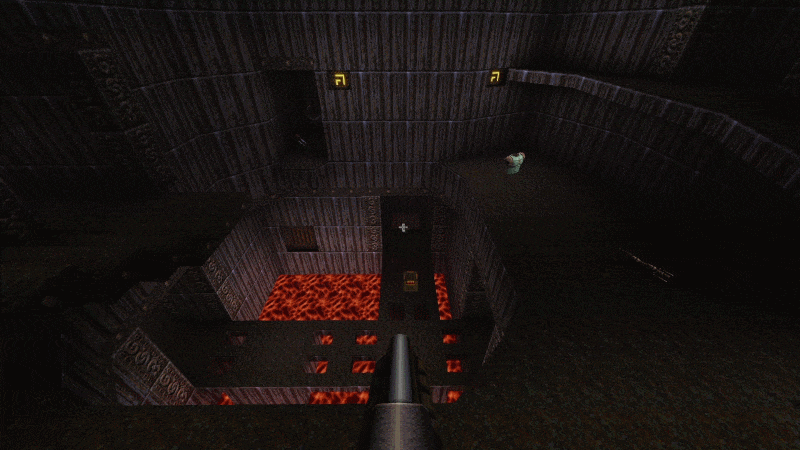
Sound cues reveal what eyes cannot
Paying attention to sounds is vitally important to high-level competitive Quake, so wear some darn headphones.
Quake has no footsteps (hooray!), but players make plenty of other sounds: grunts from jumping, yelps of pain, thuds from dropping a certain distance, splashes, teleporter whooshes, gunfire, and importantly, weapon / item pickup noises. If you learn a map’s layout and where some key items are, you can start to intuit your opponent’s location just from distant sounds. The armour pick-up noise is especially distinctive, as are those for power-ups like Quad, Pent, and Megahealth.
The small, classic dueling map DM4 (The Bad Place) is a great opportunity to learn sound cues. One example: The Red Armour is near the top of the map in a room you must drop into from a catwalk. Dropping down will make a player grunt, and then grabbing the Red Armour — and Rocket Launcher, which is right next to it..this game is wild! — will play those pick-up sounds. So if you hear a grunt quickly followed by the armour “ching ching” and the gun-grab noise, you know your foe just got the Red Armour and is about to teleport onto the lava bridge at the bottom of the map. You should already have a rocket headed there.
Or are they? Maybe they know you know. Hmm, you’re perched like a vulture waiting for them to appear down on the lava bridge but they’re not teleporting in. Uh-oh. Instead you hear a rocket blast. Ah, they probably just rocket-jumped out of the Red Armour pit and will instead come back out near the top of the map.
This situation has further nuances. In real Quake (I haven’t been able to make it work in this remaster) you can actually use a special technique to drop into DM4’s Red Armour area without making a grunt. (It involves pushing yourself into the corner formed by the catwalk and the wall as you fall, which creates fall-slowing friction for some reason.) If you manage a quiet drop, you can potentially grab the S-tier items and teleport out all in rapid succession, faster than your opponent can react.
How to win at deathmatch, summarised
Learn map layouts and item locations. Control the map by securing the key items (Rocket Launcher, Lightning Gun, Red Armour, Quad, Pent, Megahealth) before your foe can. Once you manage that, maintain control of these resources by picking them up again just as they respawn.
Shoot rockets at your enemy’s feet to take advantage of hard-to-avoid splash damage and to knock them around. Use hitscan weapons, preferably Lightning Gun, while the opponent’s stuck in the air. Listen carefully for sounds to learn what your opponent’s doing even when you can’t see them. And finally…
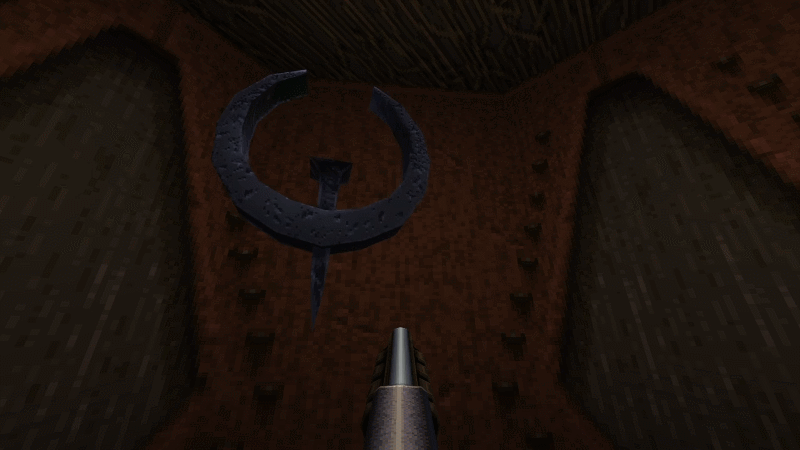
Take a moment to set your config
Enough gameplay — let’s get technical. Quake set a new standard for customisability in video games, going so far as to expose a text-based “console,” bound to the tilde key (this thing: ~), that let you type in hundreds of commands to change how the game and its engine functioned.
Luckily, a majority of the most important things you might want to tweak are now exposed in the game’s more user-friendly option menus. Night Dive did a good job of picking sensible defaults, with useful features like always run enabled and junk like mouse smoothing disabled.
However, this game…isn’t truly Quake. The remaster runs on a proprietary Night Dive engine called KEX, and veterans may notice the game doesn’t feel 100% like they remember, particularly in regard to smoothness and movement. You can address this somewhat by playing with graphical and engine settings; look to the game’s Steam forums for specific fix suggestions.
The console gets shit done
Bored with the menus? Go deeper by delving into the console. Call it up with tilde (~), type a letter, and press tab. That will trigger autocomplete, showing you every console command that matches the string you typed. I remember spending many hours laboriously testing a majority of these back when Quake shareware first hit; talk about intimidating first impressions! These days you can just look them up online. With a little practice, you’ll learn to bind and unbind keys, alter variables that control aspects of the graphics, sound, and engine, enable cheats, and lots of other useful stuff.
I recommend putting some thought into binding important weapons to handy keys. I like Rocket Launcher on E, Lightning Gun on R, and Grenade Launcher on F. The console commands for this are:
bind f “impulse 6”
bind e “impulse 7”
bind r “impulse 8”
You really ought to be able to do that in the menus, but I guess Night Dive wants you to use the new console-style weapon-selection wheel (Q by default). That might be alright in single-player (not really) but multi? No way, too slow. Also, there’s currently a bug, at least on PC, whereby bringing up the weapon wheel will make the game run less smoothly for the rest of the session. Needless to say, I recommend unbinding the weapon wheel. You can do that in the menus or with this console command:
unbind q *weaponwheel
Lastly, if you run into jerks online, like transphobes or something, a good trick is to hack their computer (ask your one cousin) and bind all keys in kexengine.cfg to “quit”.
Better living through aliases
Another of Quake’s countless innovations was rudimentary scripting capability via something called aliases. An alias is a string of commands that you assign a name, effectively making it a command itself. A simple alias called “ghostgod” could be defined with:
alias ghostgod “noclip; wait; god”
Now “ghostgod” is a command that you can bind to a key:
bind k ghostgod
Pressing K will execute the alias called ghostgod, which toggles god mode (invincibility cheat) and noclip mode (which lets you fly and pass through walls) on or off each time you invoke it. Fancier aliases can rebind the very keys they’re assigned to in order to work with other aliases and create more advanced functionality, which can get confusing. Again, Quake’s Steam forums are a good place to seek help.
Anyway, aliases fuckin’ rule, making it possible to automate annoying bits of gameplay to achieve more optimal results. For example, I really like having an alias that switches to and fires the Lightning Gun until I release the button, at which point the alias switches back to my main squeeze, the Rocket Launcher. Other people like the ability to quickly switch to and fire a rocket; I wrote one that quickly spams grenades. Some players even used to try and create rocket-jumping aliases, because who has time to glance at their feet?
This Quake remaster (rudely) changes quite a few commands, keybind names, and even alias syntax rules, so aliases written for other versions of Quake don’t necessarily work here and may need to be adapted. In the following section you’ll find several aliases I’ve adapted for this weird new reality.
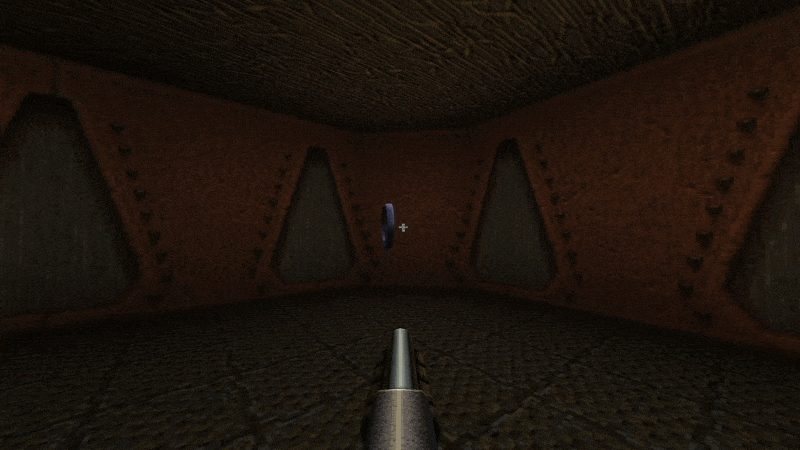
Save your fave settings in autoexec.cfg
When you find some useful settings to change or have devised some sweet aliases, it’s helpful to write the commands in an external config file to ensure they stick around. On startup Quake automatically executes a file called autoexec.cfg. Traditionally that lives in the id1 folder, but in this remaster you need to put it in %userprofile%Saved GamesNightdive StudiosQuake.
Here’s what my autoexec.cfg looks like after messing around with the remaster a bit. Apologies for the text formatting, Kinja wasn’t up to it:
bind right “exec autoexec.cfg” // to re-activate when needed
bind left_brack “cheat1"
bind right_brack “cheat2"
bind backslash “cheat3"
// combine jump + move up into one key (handy for noclip)
alias +myjump “in_jump 0; in_up 0; unbind space -myjump”
alias -myjump “in_jump 1; in_up 1"
bind space “-myjump; bind space +myjump”
// quick-fire grenades while held, then back to best weapon
alias +quickgren “impulse 6; wait; in_attack 0; unbind mouse_middle -quickgren”
alias -quickgren “in_attack 1; wait; impulse 7 8 5 3 4 2 1"
bind mouse_middle “-quickgren; bind mouse_middle +quickgren”
// quick-fire Lightning Gun while held, then back to best weapon
alias +shaft “impulse 8; wait; in_attack 0; unbind mouse_right -shaft”
alias -shaft “in_attack 1; wait; impulse 7 6 5 3 4 2 1"
bind mouse_right “-shaft; bind mouse_right +shaft”
alias cheat1 “noclip”
alias cheat2 “notarget”
alias cheat3 “god; impulse 9"
cl_backspeed 320 // fixes slower backstepping in remaster
cl_upspeed 320 // for faster vertical movement in noclip
r_wateralpha .35 // makes water much more transparent
r_telealpha .2 // makes teleporters much more transparent
sv_cheats 1 // enable cheats
Alas, it doesn’t seem possible to disable weapon auto-switching upon pickup, and if there’s a way to disable the underwater warping effect I’ve not found it. A bug resets r_wateralpha and such each map, so I bound a key to re-execute the autoexec.cfg when needed.
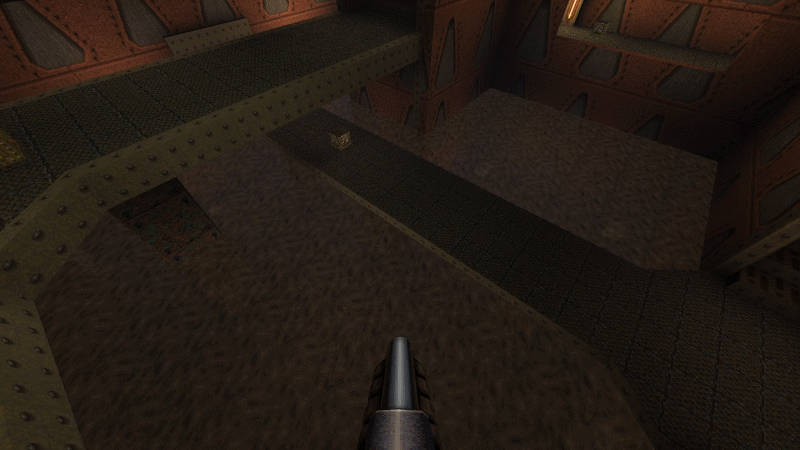
How to cheat in Quake remaster
Night Dive even changed a few of the cheat commands for some reason. I don’t currently know how to give yourself the silver / gold keys or the Pentagram of Protection, for example. (Maybe you do?) But these console cheats (adapted from an ancient QuakeWiki page) all work provided that sv_cheats is set to 1. Note: So far there are no known methods to cheat in the console versions.
god // Toggles god mode (invincibility)
noclip // Toggles geometry collision + flight
fly // Like noclip but strangely annoying
notarget // Toggles passive monsters
give h # // Set health to #
give s # // Set shells to #
give n # // Set nails to #
give r # // Set rockets to #
give c # // Set cells to #
give 3 // Get Super Shotgun
give 4 // Get Nailgun
give 5 // Get Super Nailgun
give 6 // Get Grenade Launcher
give 7 // Get Rocket Launcher
give 8 // Get Lightning Gun
impulse 9 // Get all weapons and full ammo
impulse 11 // Get one rune (up to four)
impulse 255 // Get Quad Damage
map [name] // Warp to map (ex: E4M6, DM6, HIPDM1)
skill # // Sets difficulty level (0-3)
The last two aren’t actually cheats but just very handy commands. Note that everything is case sensitive, so stick to lowercase. And you can only load maps from the mission packs, like HIPDM1, if you’ve first loaded that expansion from the New Game menu.
While it’s not a cheat, playing with sv_gravity is a lot of fun too. Its normal value is 800. And to check out Quake single-player’s lone low-gravity map, Ziggurat Vertigo, enter “map e1m8”.
Go forth and frag
That about covers all the Quake basics I wanted to touch on, as well as a few more advanced bits. Whether you’re a longtime vet or a relative newcomer, I hope you keep enjoying Quake for years to come. It’s a wonderful game, as timeless as it is strange. Keep Quake weird.
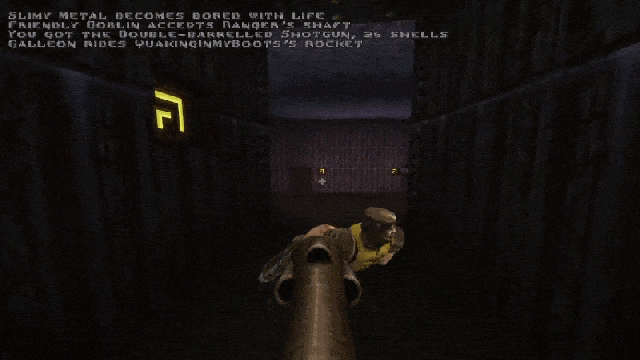
Leave a Reply